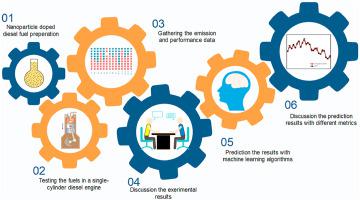Our official English website, www.x-mol.net, welcomes your
feedback! (Note: you will need to create a separate account there.)
Experimental Investigation and Prediction of performance and emission responses of a CI engine fueled with different metal-oxide based nanoparticles–diesel blends using different machine learning algorithms
Energy ( IF 9.0 ) Pub Date : 2021-01-01 , DOI: 10.1016/j.energy.2020.119076 Ümit Ağbulut , Ali Etem Gürel , Suat Sarıdemir
Energy ( IF 9.0 ) Pub Date : 2021-01-01 , DOI: 10.1016/j.energy.2020.119076 Ümit Ağbulut , Ali Etem Gürel , Suat Sarıdemir

|
Abstract Deep learning (DL), Artificial Neural Network (ANN), Kernel Nearest Neighbor (k-NN), and Support Vector Machine (SVM) have been applied to numerous fields owing to their high-accuracy and ability to analyze the non-linear problems. In this study, these machine learning algorithms (MLAs) are used to predict emission and performance characteristics of a CI engine fuelled with various metal-oxide based nanoparticles (Al2O3, CuO, and TiO2) at a mass fractions of 200 ppm. Assessed parameters in the study are carbon dioxide (CO), nitrogen oxide (NOx), exhaust gas temperature (EGT), brake specific fuel consumption (BSFC), and brake thermal efficiency (BTE). To evaluate the success of algorithms, four metrics (R2, RMSE, rRMSE, and MBE) are discussed in detail. Tests performed at varying engine speeds from 1500 rpm to 3400 rpm with the intervals of 100 rpm. The addition of nanoparticles simultaneously reduced CO and NOx emissions because they ensured more complete combustion thanks to their inherent oxygen, the higher surface to volume ratio, superior thermal conductivities and their catalytic activity role. Further, the nano-sized particles ensured an accelerated heat transfer from the combustion chamber. In comparison with that of neat diesel fuel, the reduction in NOx is found to be 3.28, 7.53, and 10.05%, and the reduction in CO is found to be 8.3, 11.6, and 15.5% for TiO2, Al2O3, and CuO test fuels, respectively. Moreover, the presence of nanoparticles in test fuels has improved engine performance. As compared with those of neat diesel fuel, the doping of nanoparticles drops the BSFC value to be 5.54, 7.89, and 9.96% for TiO2, CuO, and Al2O3, respectively, and enhanced BTE value to be 6.15, 8.87, and 11.23% for TiO2, CuO, and Al2O3, respectively. On the other hand, it can be said that all algorithms presented very satisfying results in the prediction of CI engine responses. All R2 has changed between 0.901−0.994, and DL has given the highest R2 value for each engine response. In terms of rRMSE, all results (except for one result in k-NN) are categorized as “excellent” according to the classification in the literature. Considering all metrics together, DL is giving the best results in the prediction of engine responses for the dataset used in this paper. Then it is closely followed by ANN, SVM, and k-NN algorithms, respectively.
中文翻译:

使用不同机器学习算法对以不同金属氧化物纳米颗粒-柴油混合物为燃料的 CI 发动机的性能和排放响应进行实验研究和预测
摘要 深度学习 (DL)、人工神经网络 (ANN)、核最近邻 (k-NN) 和支持向量机 (SVM) 因其高精度和非线性分析能力而被应用于众多领域。问题。在本研究中,这些机器学习算法 (MLA) 用于预测以质量分数为 200 ppm 的各种基于金属氧化物的纳米粒子(Al2O3、CuO 和 TiO2)为燃料的 CI 发动机的排放和性能特征。研究中的评估参数包括二氧化碳 (CO)、氮氧化物 (NOx)、废气温度 (EGT)、制动比燃料消耗 (BSFC) 和制动热效率 (BTE)。为了评估算法的成功,详细讨论了四个指标(R2、RMSE、rRMSE 和 MBE)。在 1500 rpm 至 3400 rpm 的不同发动机转速下以 100 rpm 的间隔进行测试。添加纳米颗粒同时减少了 CO 和 NOx 的排放,因为它们固有的氧气、更高的表面积与体积比、优异的导热性和催化活性作用确保了更完全的燃烧。此外,纳米尺寸的颗粒确保了来自燃烧室的加速传热。与纯柴油相比,二氧化钛、氧化铝和氧化铜测试燃料的 NOx 减少量分别为 3.28、7.53 和 10.05%,CO 减少量分别为 8.3、11.6 和 15.5% , 分别。此外,测试燃料中纳米颗粒的存在提高了发动机性能。与纯柴油相比,纳米颗粒的掺杂使 BSFC 值降至 5。TiO2、CuO 和 Al2O3 的 BTE 值分别为 54、7.89 和 9.96%,TiO2、CuO 和 Al2O3 的 BTE 值分别提高到 6.15、8.87 和 11.23%。另一方面,可以说所有算法在 CI 引擎响应的预测中都呈现出非常令人满意的结果。所有 R2 都在 0.901-0.994 之间变化,并且 DL 为每个发动机响应给出了最高的 R2 值。在rRMSE方面,根据文献中的分类,所有结果(k-NN中的一个结果除外)都被归类为“优秀”。综合考虑所有指标,深度学习在预测本文中使用的数据集的引擎响应方面给出了最佳结果。紧随其后的是 ANN、SVM 和 k-NN 算法。TiO2、CuO 和 Al2O3 分别为 23%。另一方面,可以说所有算法在 CI 引擎响应的预测中都呈现出非常令人满意的结果。所有 R2 都在 0.901-0.994 之间变化,并且 DL 为每个发动机响应给出了最高的 R2 值。在rRMSE方面,根据文献中的分类,所有结果(k-NN中的一个结果除外)都被归类为“优秀”。综合考虑所有指标,深度学习在预测本文使用的数据集的引擎响应方面给出了最佳结果。紧随其后的是 ANN、SVM 和 k-NN 算法。TiO2、CuO 和 Al2O3 分别为 23%。另一方面,可以说所有算法在 CI 引擎响应的预测中都呈现出非常令人满意的结果。所有 R2 都在 0.901-0.994 之间变化,并且 DL 为每个发动机响应给出了最高的 R2 值。在rRMSE方面,根据文献中的分类,所有结果(k-NN中的一个结果除外)都被归类为“优秀”。综合考虑所有指标,深度学习在预测本文使用的数据集的引擎响应方面给出了最佳结果。紧随其后的是 ANN、SVM 和 k-NN 算法。DL 给出了每个发动机响应的最高 R2 值。在rRMSE方面,根据文献中的分类,所有结果(k-NN中的一个结果除外)都被归类为“优秀”。综合考虑所有指标,深度学习在预测本文使用的数据集的引擎响应方面给出了最佳结果。紧随其后的是 ANN、SVM 和 k-NN 算法。DL 给出了每个发动机响应的最高 R2 值。在rRMSE方面,根据文献中的分类,所有结果(k-NN中的一个结果除外)都被归类为“优秀”。综合考虑所有指标,深度学习在预测本文使用的数据集的引擎响应方面给出了最佳结果。紧随其后的是 ANN、SVM 和 k-NN 算法。
更新日期:2021-01-01
中文翻译:

使用不同机器学习算法对以不同金属氧化物纳米颗粒-柴油混合物为燃料的 CI 发动机的性能和排放响应进行实验研究和预测
摘要 深度学习 (DL)、人工神经网络 (ANN)、核最近邻 (k-NN) 和支持向量机 (SVM) 因其高精度和非线性分析能力而被应用于众多领域。问题。在本研究中,这些机器学习算法 (MLA) 用于预测以质量分数为 200 ppm 的各种基于金属氧化物的纳米粒子(Al2O3、CuO 和 TiO2)为燃料的 CI 发动机的排放和性能特征。研究中的评估参数包括二氧化碳 (CO)、氮氧化物 (NOx)、废气温度 (EGT)、制动比燃料消耗 (BSFC) 和制动热效率 (BTE)。为了评估算法的成功,详细讨论了四个指标(R2、RMSE、rRMSE 和 MBE)。在 1500 rpm 至 3400 rpm 的不同发动机转速下以 100 rpm 的间隔进行测试。添加纳米颗粒同时减少了 CO 和 NOx 的排放,因为它们固有的氧气、更高的表面积与体积比、优异的导热性和催化活性作用确保了更完全的燃烧。此外,纳米尺寸的颗粒确保了来自燃烧室的加速传热。与纯柴油相比,二氧化钛、氧化铝和氧化铜测试燃料的 NOx 减少量分别为 3.28、7.53 和 10.05%,CO 减少量分别为 8.3、11.6 和 15.5% , 分别。此外,测试燃料中纳米颗粒的存在提高了发动机性能。与纯柴油相比,纳米颗粒的掺杂使 BSFC 值降至 5。TiO2、CuO 和 Al2O3 的 BTE 值分别为 54、7.89 和 9.96%,TiO2、CuO 和 Al2O3 的 BTE 值分别提高到 6.15、8.87 和 11.23%。另一方面,可以说所有算法在 CI 引擎响应的预测中都呈现出非常令人满意的结果。所有 R2 都在 0.901-0.994 之间变化,并且 DL 为每个发动机响应给出了最高的 R2 值。在rRMSE方面,根据文献中的分类,所有结果(k-NN中的一个结果除外)都被归类为“优秀”。综合考虑所有指标,深度学习在预测本文中使用的数据集的引擎响应方面给出了最佳结果。紧随其后的是 ANN、SVM 和 k-NN 算法。TiO2、CuO 和 Al2O3 分别为 23%。另一方面,可以说所有算法在 CI 引擎响应的预测中都呈现出非常令人满意的结果。所有 R2 都在 0.901-0.994 之间变化,并且 DL 为每个发动机响应给出了最高的 R2 值。在rRMSE方面,根据文献中的分类,所有结果(k-NN中的一个结果除外)都被归类为“优秀”。综合考虑所有指标,深度学习在预测本文使用的数据集的引擎响应方面给出了最佳结果。紧随其后的是 ANN、SVM 和 k-NN 算法。TiO2、CuO 和 Al2O3 分别为 23%。另一方面,可以说所有算法在 CI 引擎响应的预测中都呈现出非常令人满意的结果。所有 R2 都在 0.901-0.994 之间变化,并且 DL 为每个发动机响应给出了最高的 R2 值。在rRMSE方面,根据文献中的分类,所有结果(k-NN中的一个结果除外)都被归类为“优秀”。综合考虑所有指标,深度学习在预测本文使用的数据集的引擎响应方面给出了最佳结果。紧随其后的是 ANN、SVM 和 k-NN 算法。DL 给出了每个发动机响应的最高 R2 值。在rRMSE方面,根据文献中的分类,所有结果(k-NN中的一个结果除外)都被归类为“优秀”。综合考虑所有指标,深度学习在预测本文使用的数据集的引擎响应方面给出了最佳结果。紧随其后的是 ANN、SVM 和 k-NN 算法。DL 给出了每个发动机响应的最高 R2 值。在rRMSE方面,根据文献中的分类,所有结果(k-NN中的一个结果除外)都被归类为“优秀”。综合考虑所有指标,深度学习在预测本文使用的数据集的引擎响应方面给出了最佳结果。紧随其后的是 ANN、SVM 和 k-NN 算法。











































 京公网安备 11010802027423号
京公网安备 11010802027423号